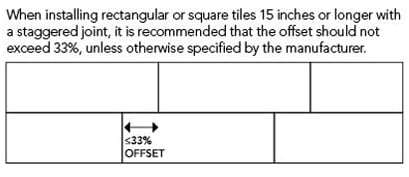Home / Resources / Product Information / Rectangular Tile Installation
Rectangular Tile: Considerations During Installation
With the renewed popularity of rectangular and plank tiles comes a need to review the factors that may affect installation. Rectangular tiles often have variations in height, also referred to as lippage.
As defined by ANSI (American National Standards Institute) standard A108.02, Section 4.3.7: lippage refers to differences in elevation between edges of adjacent tile modules. ANSI A137.1 defines acceptable edge warpage in terms of a percentage of the tile’s edge length, and also sets a maximum warpage amount in millimeters that cannot be exceeded, regardless of tile size. This maximum value serves as a “cap”; so that allowable warpage does not exceed a reasonable amount, even for the largest tiles. Because allowable warpage is the lesser of the allowable percentage or maximum cap, the allowable warpage for a smaller tile is generally limited by the percentage criteria and is well below the maximum cap. For example, a 6″ rectified porcelain tile’s maximum allowable warpage, based on the allowable edge warpage percentage criteria, is 0.6 mm, while a 24″; calibrated tile’s maximum allowable warpage “caps out” at 1.3 mm, or nearly 1/16″. Therefore, patterns and grout joint accommodations that work well with smaller tiles would not work with larger tiles exhibiting the maximum allowable warpage. Such tiles that are just barely within ANSI tolerances are not generally recommended for offset patterns and can be highly problematic when installed with a 50% offset and a narrow grout joint.
When offset or modular patterns are desired, strong consideration should be given to the amount of offset. For large tiles exhibiting the maximum allowable warpage, 50% offsets can exhibit lippage. To address this on a practical basis, when installing rectangular tiles 15 inches or longer with a staggered joint, it is recommended that the offset not exceed 33%, unless otherwise specified by the manufacturer.

